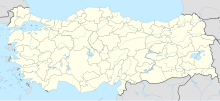Karatepe-Aslantaş Open-Air Museum
| Karatepe-Aslantaş Açık Hava Müzesi | |
| Established | 1958 |
|---|---|
| Location | Kadirli, Osmaniye Province, Turkey |
| Coordinates | 37°18′01″N 36°15′00″E / 37.30022°N 36.25004°ECoordinates: 37°18′01″N 36°15′00″E / 37.30022°N 36.25004°E |
| Type | Archaeology |
Karatepe-Aslantaş Open-Air Museum (Turkish: Karatepe-Aslantaş Açık Hava Müzesi) is an open-air museum in Osmaniye Province, Turkey. Karatepe ("black hill") is the location while Aslantaş ("lion stone") refers to the lion figure on stone sculptures. The site is situated inside a nationalpark with the same name.
The museum is located north of the 638 m (2,093 ft)-high Karatepe at Kızyusuflu village in Kadirli district of Osmaniye Province. Its distance to Kadirli is 22 km (14 mi) and to Osmaniye 30 km (19 mi). It is situated to the west of Aslantaş Dam resorvoir, and is part of the Karatepe-Aslantaş National Park.
The location is named Karatepe-Aslantaş to distinguish it from other places with the name Aslantaş, which are named by the locals after lion stone statues. The museum ground is located on a hill in a woodland landscape overlooking the Andırın Plain, and is a peninsula surrounded on three sides by the Aslantaş Dam reservoir.
Karatepe is on the historic caravan trail, called "Akyol", which connects Cilicia with Central Anatolia over Andırın-Göksün. The route was used by Hittites, Crusaders and recently by the Yörüks.
The site contains the remains of an ancient fortress dating back to the 8th century BC. Originally named Azatiwadaya, the walled settlement was founded by Azatiwada, the king of Quwê, a Neo-Hittite kingdom. It was built for defense against invaders from the north. The fortification and other territory areas of the kingdom were conquered by the Assyrian Empire from the east either in 720–725 BC term or in 680 BC.
...
Wikipedia

